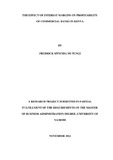| dc.description.abstract | Despite the removal of restrictions and reforms in the banking sector to facilitate the adoption of a market oriented interest rate policy, interest rates are yet to become fully responsive to the market. The Central Bank of Kenya as the regulatory authority of the country‟s banking and financial system has been urging the banks to reduce the interest rate spread (IRS) in a rational manner. Despite these efforts, the IRS has remained high in the banking sector of the country. The objective of the study is to determine the relationship between interest margins and profitability of commercial banks in Kenya. This study adopted an explanatory approach by using panel research design to fulfill the research objective. The population of this study comprised of all licensed commercial banks in Kenya between the period of 2006 and 2010. A sample of 35 banks was selected for the study. The study employed secondary data. The data was collected from the Central Bank of Kenya and Banking survey 2010. The collected data was analyzed using descriptive statistics, graphs, multiple linear regression analysis and inferential statistics.
The study found that that both net interest margin and return on assets rose over the period under analysis. The study further found that the relationship was not significant given the non-significance of the F-statistic (F=4.550, p=0.123). The study also found that net interest margin had a negative effect on return on assets (-3.926). However, the impact was not significant at 5% level (p = 0.123). The study concludes that commercial banks in Kenya were making better investment decisions over the period of study. The study further concludes that commercial banks in Kenya were profitable over the period covered in the study. Additionally, the study concludes that net interest margin does not have a significant impact on bank profitability.
The levels of net interest margins among commercial banks, though positive, were low. The study recommends that banks should look for better and more ways of investing their funds in order to gain larger net interest margins. The study recommends that there is need for commercial banks in Kenya to devise other ways of driving up their profitability. This is because, over the period of analysis, the overall profitability of banks was low, declining even in some years and it is therefore important that measures be devised to drive up profitability in the banking industry. | en_US |



